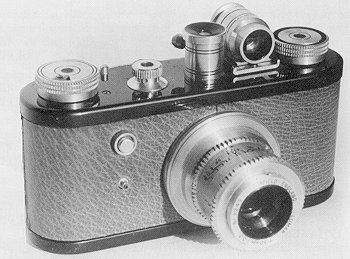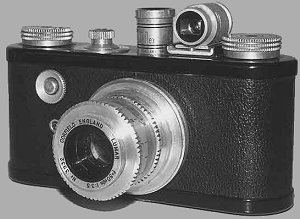|
The Periflex Era
Sir Kenneth began to
think about the possibility of producing a camera. The initial idea
was to produce a subminiature version of a 35mm camera using a 16mm
film cassette. A lot of development work was carried out, but it became
obvious that the concept was wrong. Such a camera would only sell in
comparatively small numbers and only a few dealers would stock, or
even print from, the film in the unique format. The project was
dropped, but the seed had been sown, and soon thoughts turned towards
a camera using 35mm film.
The initial concept was
to produce an economically priced, high quality 35mm camera body with
a focal plane shutter and a Leica lens mount, so that Leica owners
could purchase one for use as a second body. Another consideration was
that at the time there were a lot of second hand Leica lenses on the
market. This would make it possible for someone to purchase the camera
and a Leica lens, and end up with a high quality camera at an
economical price. In the early 1950's, import restrictions meant
that new Leica equipment was in short supply in the shops. A lot of manufacturers were
producing all kinds of accessories for Leica cameras, as it was often
very difficult to obtain the genuine article . It was possible to purchase almost any
accessory, but this was the first time that anyone had attempted to
offer a cheaper alternative to the camera body itself.
Work quickly got
underway. Many of the parts were made from aluminium instead of the
usual brass, as this was both cheaper and easier to manufacture. The
shutter was designed to work from a thirtieth to a thousandth of a
second using a fixed tension blind with a variable slit. It was made
from rubberised fabric. A glass film
pressure plate was incorporated as it was easy to polish and avoided
film scratches. Another innovation was the sprocket-less film
transport which simplified the wind-on mechanism and avoided jamming.
It had been decided to include some kind of reflex focussing system.
The difficulty was to fit it in the small confined space above the
shutter. Sir Kenneth's solution was to use a small periscope which
could be lowered behind the lens for focussing. This would allow the
user to view the central part of the image through the lens and so
focus the image. The periscope was then retracted and the photograph
taken. A separate conventional viewfinder was provided to compose the
image.
 |
The camera top plate with the periscope in the
centre. The lever to lower and raise the periscope can be seen
just above the letter 'p'. |
The Corfields were
delighted with their new camera. The final design was so good that it
could easily compete with the competition as a product in its own
right. To sell it as just a camera body would severely limit its
potential in the marketplace, and so it was now time to find a
suitable lens. Initially the leading UK lens manufacturers were
contacted, but not one of them could produce a quality product at the
right price. The next step was to contact the European manufacturers,
but this became unnecessary after Sir Kenneth was introduced to
Frederick Archenhold. He was an experienced optician who worked for
the British Optical Lens Co. in Walsall. He suggested that Corfields
could make the mount and his company could make the lenses. They had
just installed new lens coating equipment and could easily mass
produce lenses to a high standard. After some thought Sir Kenneth
decided that this was a good option, and gave Frederick the go ahead to
design the optics and provide Corfields with a specification for the
mount. The lens mount and body were made of aluminium which could be
polished to provide a similar finish to the satin chrome finish which
was popular at the time. The new lens was called the Lumar and initial
prototypes performed extremely well.
New production
facilities were now required to manufacture the camera and lens.
Luckily the company was able to purchase one of its immediate
neighbours in Merridale Works to provide the much needed extra space.
New machinery was soon installed and everything was made ready for
production to begin. The first cameras had black anodised top and
bottom plates, and were finished in pigskin. The camera was named after
its unique periscope focussing mechanism and was called the Periflex.
John's workload was lightened during this expansion as he appointed
Eric Isles as technical assistant, and Gerry Whitton as toolmaker.
Prior to this John had personally designed, drawn and dimensioned
every component, and made all of the tools for the various products.
 |
The original Periflex with black top and bottom
plates, and pigskin covering. Only the first 200 or so were
covered in pigskin. It was replaced by black leathercloth
which was easier to handle and more fashionable. |
| The black leathercloth version. The ring around
the shutter release can be unscrewed to allow the fitting of a
Leica-type cable release. The flash socket is now recessed
into the camera body instead of standing proud. |
 |
The first the public
heard of the camera was a pre-launch article which appeared in the
January 28th, 1953 edition of Amateur Photographer. It consisted of
advance details supplied by Corfields and looked forward to the
appearance of the camera. The edition of May 20th was the first to
announce the arrival of the new camera. The write-up
included the following:
The camera has a
somewhat Leitz body style, but different in having the periscope
eyepiece and the unusual tan pigskin covering. The body is constructed
of 16 s.w.g. light alloy, has a removable back and base. Equipped with
a Leica thread lens mount, collimation had been carried out to a high
degree of accuracy to suit the widest apertures - plus or minus
0.0004in from flange to the face of the film plane. The camera was
very comfortable in the hand, with the shutter release being placed on
the front of the body in a natural position for the index finger of
the right hand. Around the shutter release was a removable collar
which, when unscrewed, would allow the fitting of a Leitz cable
release. Flash synchronisation was provided by the standard 3mm
co-axial socket. The prices were quoted as: body only £19.19.6d, with
50mm f3.5 Lumar lens - uncoated, £29.18s.6d, or coated £32.19s.6d.
The write-up was a
great success. As soon as the magazine reached the shops orders
started pouring in. It had only been planned to initially produce
between 25 to 30 units each week, and so the sudden demand came as a
bit of a shock. It took sometime to build up production, particularly
as the employees had to be trained in a lot of new skills.

|
After
approximately 18 months the camera underwent some cosmetic changes.
The top and bottom plates were silver anodised aluminium and the lens barrel
was simplified. Black leather strips were added to the adjustment
rings to allow the user to firmly grip them. These changes brightened
up the appearance of the camera, and gave it a more modern
look. |
 |
|

|
|
 |
|
Back |
|
Return
to the beginning
|
|
Continue |
|























